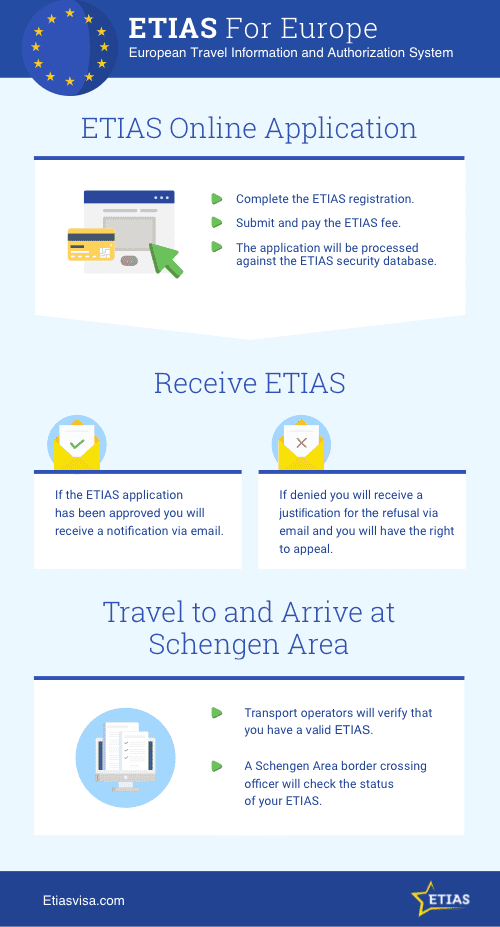
- ETIAS will become operational in 2026 , according to official EU sources.
- Visa-free visitors to the European Union will soon need to register online before travelling to Europe.
ETIAS should be operational from 2026 .
The European Parliament approved the European Travel Information and Authorisation System in 2016 to improve border security. ETIAS pre-screens travellers from visa-exempt countries before they enter the Schengen Area.
ETIAS has been under development since 2018 and the start date is now approaching. Read on to find out when ETIAS will be implemented.
IS ETIAS IN EFFECT?
The ETIAS online visa waiver service is not currently available. According to official EU sources, it will become operational in 2026 .
When ETIAS goes into effect, it will be mandatory for visitors from visa-waiver countries.

WHEN IS THE ETIAS START DATE?
Originally due for release in 2021, European authorities announced that the ETIAS start date had been pushed back.
Although the exact launch date is not yet known, ETIAS is expected to be fully operational in 2026 .
WHY HAS ETIAS BEEN DELAYED?
The ETIAS start date has been delayed because the Entry/Exit System (EES) has been delayed. ETIAS is dependent on the data provided by EES to detect security and high epidemic risks.
ETIAS can only enter into operation 5 to 6 months after EES. With EES now expected to enter into operation in October 2025, this means ETIAS cannot start before then.
As explained by Anitta Hipper, spokesperson for the Commission of home affairs, migration, and internal security: ‘The success of these systems [EES and ETIAS] depends on them being able to talk to each other. This is why it is vital we make them interoperable. As soon as possible.’
FACTORS LEADING TO THE REVISED EES AND ETIAS TIMELINE
According to European Commission spokesperson Anitta Hipper, there are several factors that have led to the revised timeline.
These factors include ‘delays in developing the system at a central level by the contractor’ plus ‘Member States when it comes to delays in the preparation for the necessary equipment to use the EES at the border crossing points’.
ETIAS TIMELINE
The European Commission introduced the idea of a European Travel Information and Authorisation System (ETIAS) in 2016.
After being approved by the European Parliament, the ETIAS Regulation was passed on July 5th, 2018.
It was originally expected that ETIAS would take around 5 years to become operational, by the end of 2021, and be fully implemented by 2022. However, several delays mean that the system is not live yet.
Under the revised timeline, laid out during the Justice and Home Affairs Council on 19-20th October 2023, ETIAS will enter into operation in 2026 .
The European Commission has said that the exact ETIAS start date will be announced as soon as it is available.
PASSENGERS WILL BE PROVIDED WITH INFORMATION AND GUIDANCE
During the months before implementation, Schengen member states will provide information about the new travel authorisation — passengers may be provided with leaflets at Schengen border checkpoints.
The leaflet will also be distributed to the embassies and consulates of all Schengen Area countries where mandatory ETIAS registration will apply.
ETIAS IMPLEMENTATION PERIOD
ETIAS will not be mandatory immediately after launch. There will be 2 short implementation periods, allowing travellers and border authorities to adapt to the new system.
STAGE 1: ETIAS TRANSITIONAL PERIOD
The ETIAS transitional period will last for 6 months after ETIAS becomes operational.
Travellers will be allowed to cross the external border, even if they do not hold a valid ETIAS. Visitors must meet all other entry requirements such as holding a valid passport.
STAGE 2: ETIAS GRACE PERIOD
A 6-month grace period will follow the transition period. During the grace period, travellers without ETIAS will be allowed to cross the border only if they are entering one of the European countries requiring ETIAS for the first time since the end of the transition period.
Travellers must hold a valid passport and meet all other entry conditions.
The grace period is the final time visa-exempt third travellers can enter without ETIAS.
Two informative leaflets prepared by the European Commission will be distributed to travellers during the transition and grace periods.
ETIAS CENTRAL UNIT OPERATORS COMPLETE TRAINING
The first batch of ETIAS Central Unit operators graduated in January 2022.
28 ETIAS application handlers, 2 team leaders, and 10 travellers and carrier support operators completed a 3-month training course.
Until the ETIAS start date, these operators will be carrying out work such as testing the system. When ETIAS is implemented, they will process applications and provide help desk assistance.
Frontex will recruit 200 additional staff members over the next 2 years to manage and operate the ETIAS Central Unit.
PREPARING FOR THE EU VISA WAIVER START DATE
With the ETIAS start date approaching, European institutions are getting ready for its implementation.
Here are some recent examples of preparations now underway.
AIR, LAND, AND SEA CARRIER REGISTRATION ONGOING
Air carriers, sea carriers, and overland coaches who transport passengers to the Schengen Area can now register with the eu-LISA’s carrier interface. This will allow them to query the IT systems managed by the agency.
It will be a legal obligation for carriers such as airlines to check ETIAS when implemented. Carriers will only be able to board passengers who receive the ‘OK to travel’ response.
A Working Group for Carriers has been established to coordinate between the eu-LISA, the European Commission, Frontex, and carriers to facilitate preparations for ETIAS.
EU-LISA INDUSTRY ROUNDTABLES
Industry Roundtables are organised by eu-LISA, the EU agency responsible for the large-scale IT systems of the European Union.
The 16th edition, ‘EES and ETIAS - Getting Ready for the Entry into Operation’ took place on 11-12 October 2022. Speakers at the event presented and discussed technological solutions and operational processes.
The eu-LISA roundtables bring together representatives of Member States, the transport industry, and other EU institutions. Stakeholders can exchange views and concerns in the lead-up to the new border management systems.
HOW TRAVEL TO EUROPE WILL CHANGE WITH ETIAS
ETIAS is similar to the United States ESTA. ETIAS is not a visa, but will be an essential travel document.
Once ETIAS is implemented, the way third-country nationals travel to Europe will change. It will be necessary to visit any Schengen country, as well as Schengen candidates like Cyprus.
BEFORE DEPARTURE
Visa-exempt travellers will need to register for ETIAS pre-departure. Passengers must receive authorisation to travel to Europe.
AT THE AIRPORT
International carriers such as airlines will verify that the visa-exempt passengers have authorisation to travel. The passenger information will be queried using the carrier interface. Only passengers who receive an ‘OK to travel’ response will be boarded.
ON ARRIVAL
Border officials will continue to verify that passengers have the relevant travel documents and meet the entry requirements.
A CHRONOLOGICAL ORDER OF ETIAS
APRIL 16TH, 2019
The European Commission welcomes the adoption of new measures that will deny terrorists and criminals the means and space to act. The European Union has adopted two Security Union legislative initiatives that were put forward by the Commission on the matters of interoperability and explosive precursors. The goal behind these measures is to allow EU information systems, including ETIAS, to work together in a more intelligent and efficient way.
SEPTEMBER 5TH, 2018
The European Council adopts the regulation to establish the ETIAS System. Herbert Kickl, Minister of the Interior of Austria, said, “ETIAS is an important tool to reinforce the control of the EU’s external border and the protection of our citizens. It will allow identifying those who may pose a security threat before they reach the European Union and deny them the authorization to travel.” After this adoption, the next step is for the Council and the European Parliament to sign the adopted regulation.
JULY 5TH, 2018
Commission welcomes the European Parliament adoption of the ETIAS system and a stronger eu-LISA Agency. Final agreement is given to establish the ETIAS system.
JULY 5TH, 2018
ETIAS Regulation is passed with 494 votes in favor, 115 against and 30 abstentions. This follows the Parliament’s green light. The legislation is then expected to be formally adopted by the Council of Ministers and then published in the Official Journal.
APRIL 25TH, 2018
European Commissioner for the Security Union, Julian King, announces that Political Consensus has been reached on ETIAS. Commission welcomes political agreement on the European Travel Information and Authorization System for a stronger and more secure Union.
DECEMBER 12TH, 2017
The EU Commission proposed to close information gaps by upgrading EU information systems for security, border and migration management and make them work together more efficiently. ETIAS would be directly affected by these improvements and upgrades.
OCTOBER 19TH, 2017
The costs of developing ETIAS are estimated at 212,1 million Euros. The Civil Liberties Committee backed the negotiating mandate with 39 votes, to 13 against and 1 abstention.
JUNE 29TH, 2017
The European Commission delivers its commitment to ensure interoperability and address the existing shortcomings of EU information systems for security and border management. The Commission proposes to strengthen the mandate of the EU Agency, as it is the agency that manages large scale security systems such as Eurodac. They also propose to create a centralized ECRIS-Third Country National System, a centralized database that will help member states verify convictions on non-EU citizens.
MAY 16TH, 2017
The European Commission presents a report on the progress made towards an effective Security Union.
- Commissioner for Migration, Home Affairs and Citizenship Dimitris Avramopoulos said: "The value of our security information is maximised when our systems talk to each other. The complex and fragmented systems we have today make us vulnerable. Actionable information is not always available for the law enforcement officials that need it. Today, we present a clear vision on how to act to correct this. To connect the dots and to eliminate blind spots to step up the security of our citizens across the EU."
- Commissioner for the Security Union Julian King said: "The recent tragic attacks in Europe have highlighted the importance of effective information sharing between Member State authorities. The approach we are outlining today sets out a targeted and intelligent way of using the existing data to best effect. What we propose would be a step-change in the way we manage data for security, helping national authorities better addressing transnational threats and detecting terrorists who act across borders."
NOVEMBER 16TH, 2016
First proposal for a regulation of the European Parliament and the Council establishing a European Travel Information and Authorization System (ETIAS) and amending regulations. The European Commission publishes this proposal.
SEPTEMBER 14TH, 2016
President Juncker announces in his State of the Union Address that a system is needed and that it would be created to protect EU citizens. We need to know who is crossing our borders. By November, we will propose an automated system to determine who will be allowed to travel to Europe. This way we will know who is traveling to Europe before they even get here.

